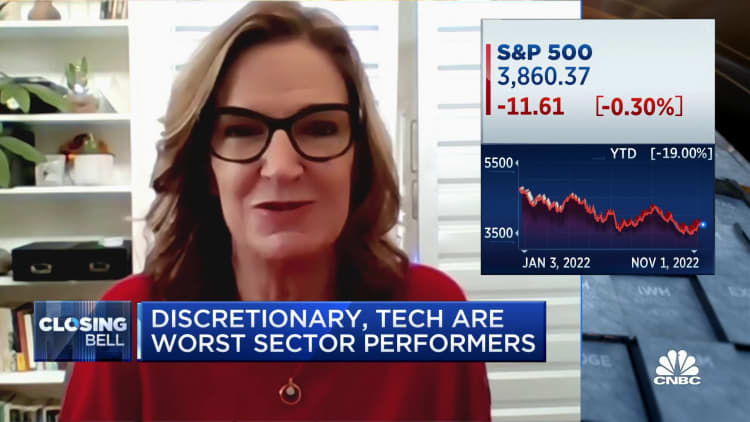
Inflation continues to suck up much of the oxygen on earnings calls, and whether it's Pepsico making more on less unit volume or Apple finding the time right to ask for more from services subscribers, the biggest firms still have the ability to pass price increases onto customers, and many are expecting that to continue. But at an economy-wide level, recent data has shown that key sales and profit metrics are warning of a potential recession.
A closely watched survey from the National Association for Business Economics has shown a decline in sales for companies that hasn't been this sharp since the mid-2020 Covid crash and is getting close to a level which corresponds to several past recessions. The Net Rising Index (NRI) for sales — the percentage of survey respondents reporting rising sales minus the percentage reporting falling sales — peaked at 74% of firms in April 2021. As of October, it's down to 36%.
"This doesn't mean the majority of firms are predicting a decline, but it is enough to be worrisome," Julia Coronado, the founder of MacroPolicy Perspectives, former Fed economist and current president of NABE, told us. "That index is down close to, but not at, recessionary levels, even as lot of companies are doing well," Coronado said.
NABE has tracked this data since the 1980s.
By another NABE measure, the net rising index for profit margins, the recession is here.
Coronado advises firms to focus on the sales decline. That's because profit margins tend to be more volatile and it is sales, as a read on demand, that drives the economy. "It is a bit more reliable, and that's flashing yellow to red. It's not over the edge, just closer to the edge," she said.
The NABE data has both good and bad news for the Fed and companies. The materials costs associated with supply chain inflation are coming off highs and dropped by 24 percentage points from a record high reading in July. That is the lowest materials costs have been since April 2021, and that is one of the forces the Fed needs as an ally to cool inflation throughout the economy.
But the labor market is still not cooperating. The Net Rising Index for wages reached its third-highest reading ever, surpassed only by January and April of this year.
"They are still raising wages and still trying to pass along the higher costs," Coronado said.
The latest jobs report on Friday showed an uptick in unemployment, but job growth that remained stronger than expectations and wage growth rising too.
Sixty-nine percent of respondents to the NABE survey indicated all or some costs are being passed on.
Wage costs and hiring expectations have declined in the NABE survey, but in Coronado's analysis of the data, there's not enough yet to make a convincing case that the Fed will reduce the size of rate increases more than the market expects, though the NABE data suggests the leading indicators should get more attention. The Fed hinted in its formal language last week that it might consider slowing its rate hikes if the data warranted, but Fed Chair Jerome Powell's press conference after the FOMC meeting muddied the picture, with the Powell giving little indication that restrictive monetary policy would soon change and the fight against inflation remaining the focus.
"Clearly, there are signs Fed policy is having its intended effect and we're entering a zone where you can ask, 'Is it having enough of an effect? How much further do they need to go?' … You don't just keep raising rates until the economy cracks," Coronado said of the NABE data. "If you're seeing enough leading indicators moderating, you can let those higher rates take effect. You apply the brake and let it flow through, maybe step down to 50 basis points and then 25. Rates are still going up, borrowing costs are still going up, and demand is still slowing," she added.
The market is expecting a 50 basis point increase at the December FOMC meeting.
Regardless of what the Fed does, the demand picture means it is going to be a tougher road for many companies with big decisions to be made about productivity and pricing to keep market share. The relief showing up on the supply side, in data such as the materials input costs, will factor into the decisions that businesses have to make as top line sales growth cools. "Do they want to hold onto margins and not pass on that input cost relief," Coronado asked. "It may be better for stability of market share to give the consumer some relief. It may be better for stability of the economic cycle overall."

Companies are still testing the boundaries of pricing power. The NABE data shows that even as the goods sector sees the steepest decline in sales outlook, 88% of firms still say they have some pricing power. "Maybe they are not reading the writing on the wall," Coronado said.
What she sees for certain in the data is a "pronounced shift" relative to earlier in the year, but a consumer and Fed that remain hard to pinpoint.
"Clearly, the economy is slowing, sales are slowing, and margin pressure is real," she said. "That comes through loud and clear."
But with wages still rising, even not keeping up with inflation, supply side declines may need more help from the demand side before the Fed can alter its view. "This is an ocean liner of an economy and as long as people have jobs and income, it won't go over the edge," she said.
After the Fed followed through on its 75 basis point hike this week, the question is how flexible the central bank will be going forward to a slowing down — how much of a signal they take from leading indicators.
"It's just been such an uncertain environment, and they've been wrong enough on enough things they won't pound the table on their forecast," Coronado said.
Members of the Fed will say "we're getting closer to the rate to restrict the economy," — and in fact several Fed presidents said that on Friday — but that will continue to complicated by a Fed view that Coronado said can be summed up as, "we need to see more."
"There's no doubt that the Fed doesn't believe it's done enough to conquer inflation and the question is really around nuance," Coronado said in a CNBC interview last week. "There is no nuance on a pivot or cutting of rates, but it's around pace. That's quite a limited nuance around a very hawkish path."






